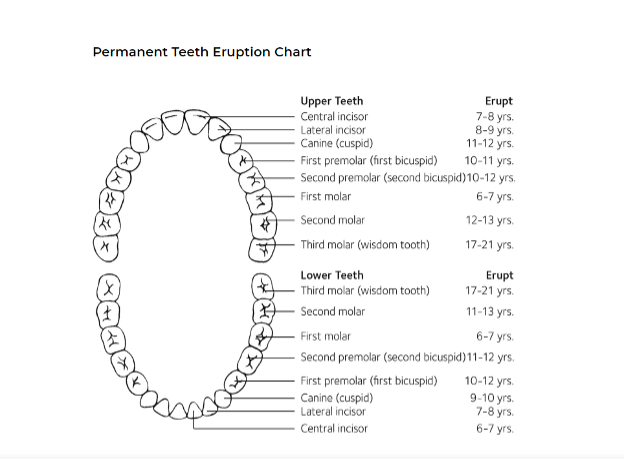
Welcome to McDonough Orthodontics, where we prioritize your child’s dental health and smile confidence. In our exploration of pediatric dental care, we delve into a common concern for parents: missing permanent teeth in children. As kids transition from baby teeth to permanent ones, it’s natural to wonder why a tooth might be missing. In this blog, we’ll unravel the mysteries behind missing permanent teeth while offering insights into treatment options. At McDonough Orthodontics, we ensure your child’s smile flourishes with confidence and vitality.
Exploring Causes of Missing Permanent Teeth
Children typically lose their baby teeth between the ages of 7 and 12. In most cases, the eruption of the underlying permanent tooth follows within six months after losing a baby tooth. The chart below illustrates the age ranges for each tooth to erupt.
If a child loses a baby tooth but the permanent tooth does not appear in a reasonable amount of time, it could be for several reasons. Here are the two most common reasons:
Crowded Teeth
When the teeth are too crowded, it can happen that there isn’t enough space for the permanent tooth to emerge properly after the loss of a baby tooth. Here are two common problems that can result from crowded teeth affecting the eruption of a permanent tooth:
- The permanent tooth may become impacted. In other words, it cannot erupt through the gums properly. Usually, this happens when there isn’t enough space for the tooth to grow, so it gets trapped under the gum or against other teeth. It’s like a roadblock, and the permanent tooth can’t get through!
- The tooth may emerge improperly, leading to teeth misalignment and bite problems.
It’s essential to address crowding early on to prevent complications and ensure the healthy eruption of permanent teeth.
The Permanent Tooth is Missing
The other reason for a missing permanent tooth is that the permanent tooth never developed. A tooth can fail to develop for various reasons:
- The tooth fails to develop, often due to genetic factors inherited from both parents.
- Injury to the mouth can damage the developing permanent tooth, leading to its absence.
- Some dental conditions or syndromes affect tooth development, resulting in missing permanent teeth.
If you notice a missing permanent tooth in your child’s mouth, it’s important to schedule your child to see an orthodontist for evaluation and appropriate treatment.
How Can a Missing Tooth Affect Teeth Alignment?
One of the primary concerns associated with a permanent tooth is its impact on dental alignment and bite. Each tooth plays a crucial role in maintaining proper spacing and alignment. When a tooth is missing, neighboring teeth may shift positions over time, leading to crowding, spacing, or misalignment. These changes can affect the aesthetics of your child’s smile and increase the risk of other dental problems, such as tooth decay and gum disease.
Treatment Options for a Missing Permanent Tooth
We aim to provide personalized orthodontic treatment solutions tailored to your child’s needs. Depending on the circumstances, treatment options may include:
Treatment for Impacted Teeth: The treatment for an impacted tooth depends on its location and severity. Mild cases may benefit from orthodontic treatments, helping to bring the tooth to its correct position. Severe cases, especially involving wisdom teeth, often require surgical exposure or removal.
Orthodontic Treatment: Orthodontic treatment, such as braces or clear aligners, can help gradually shift the teeth into their proper positions, addressing spacing and alignment issues associated with missing teeth.
Dental Implants: For cases where a single tooth is missing, we may recommend a dental implant to replace the absent tooth permanently. If your child is not yet at an age suitable for dental implants, you may consider other options, such as dental bridges or removable partial dentures.
Early intervention is critical when addressing missing permanent teeth in children. By addressing the issue promptly, we can help minimize long-term complications and ensure optimal dental health and aesthetics as your child grows.
When Should My Child See an Orthodontist?
There is no exact age for children to begin orthodontic treatment. However, the American Association of Orthodontists(AAO) recommends your child visit an orthodontist around age seven.
McDonough Orthodontics offers complimentary visits for children aged 7-12, aiming to monitor dental changes from the transition of baby teeth to adult teeth. We call it OWLS for Orthodontic Wellness Program. By detecting problems early, OWLS facilitates a healthy, lifelong smile. Our program watches for potential problems like missing, extra, or impacted teeth, cross-bites, habits, growth problems, unusual eruption patterns, and facial asymmetry. To learn more about our OWLS program, click on the picture below and watch are brief informative video:
Early Intervention for Lifelong Dental Health
In conclusion, understanding why permanent teeth are missing in children is vital for their dental health and confidence. At McDonough Orthodontics, we offer tailored treatment options to address crowding, missing teeth, and developmental factors. Early intervention is critical to preventing long-term complications.
By participating in our OWLS program, parents can trust that their child’s facial and dental development is expertly supervised, potentially saving time, money, and future discomfort. At McDonough Orthodontics, we’re dedicated to nurturing your child’s smile with confidence and vitality.
Contact us if you are concerned your child may have a missing tooth, have questions about their dental development, or to enroll your child in our OWLS program.
Your Friendly Orthodontic Team

